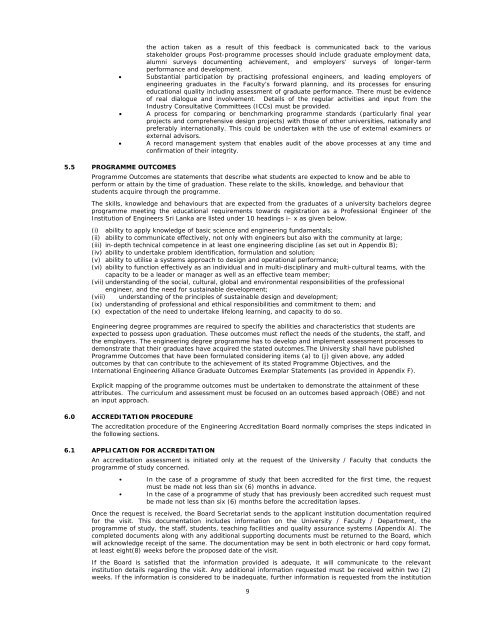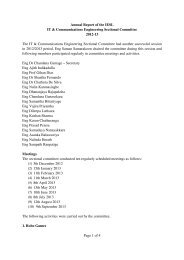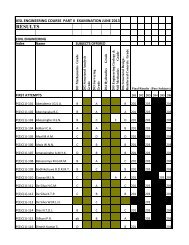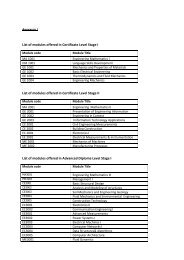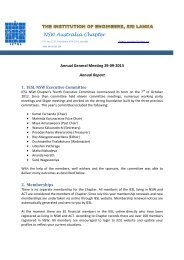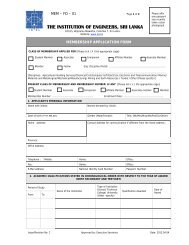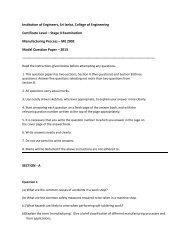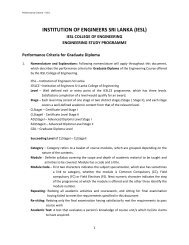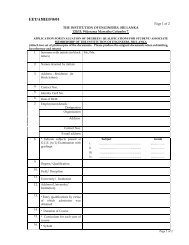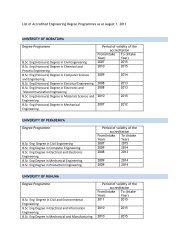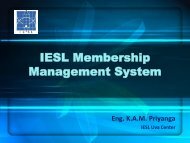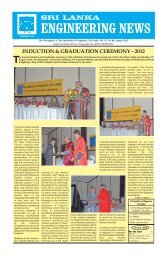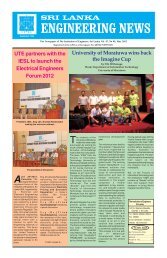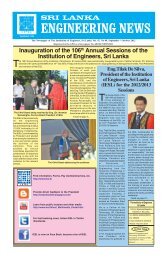1 - The Institution of Engineers Sri Lanka
1 - The Institution of Engineers Sri Lanka
1 - The Institution of Engineers Sri Lanka
Create successful ePaper yourself
Turn your PDF publications into a flip-book with our unique Google optimized e-Paper software.
the action taken as a result <strong>of</strong> this feedback is communicated back to the variousstakeholder groups Post-programme processes should include graduate employment data,alumni surveys documenting achievement, and employers’ surveys <strong>of</strong> longer-termperformance and development.• Substantial participation by practising pr<strong>of</strong>essional engineers, and leading employers <strong>of</strong>engineering graduates in the Faculty’s forward planning, and its processes for ensuringeducational quality including assessment <strong>of</strong> graduate performance. <strong>The</strong>re must be evidence<strong>of</strong> real dialogue and involvement. Details <strong>of</strong> the regular activities and input from theIndustry Consultative Committees (ICCs) must be provided.• A process for comparing or benchmarking programme standards (particularly final yearprojects and comprehensive design projects) with those <strong>of</strong> other universities, nationally andpreferably internationally. This could be undertaken with the use <strong>of</strong> external examiners orexternal advisors.• A record management system that enables audit <strong>of</strong> the above processes at any time andconfirmation <strong>of</strong> their integrity.5.5 PROGRAMME OUTCOMESProgramme Outcomes are statements that describe what students are expected to know and be able toperform or attain by the time <strong>of</strong> graduation. <strong>The</strong>se relate to the skills, knowledge, and behaviour thatstudents acquire through the programme.<strong>The</strong> skills, knowledge and behaviours that are expected from the graduates <strong>of</strong> a university bachelors degreeprogramme meeting the educational requirements towards registration as a Pr<strong>of</strong>essional Engineer <strong>of</strong> the<strong>Institution</strong> <strong>of</strong> <strong>Engineers</strong> <strong>Sri</strong> <strong>Lanka</strong> are listed under 10 headings i– x as given below.(i) ability to apply knowledge <strong>of</strong> basic science and engineering fundamentals;(ii) ability to communicate effectively, not only with engineers but also with the community at large;(iii) in-depth technical competence in at least one engineering discipline (as set out in Appendix B);(iv) ability to undertake problem identification, formulation and solution;(v) ability to utilise a systems approach to design and operational performance;(vi) ability to function effectively as an individual and in multi-disciplinary and multi-cultural teams, with thecapacity to be a leader or manager as well as an effective team member;(vii) understanding <strong>of</strong> the social, cultural, global and environmental responsibilities <strong>of</strong> the pr<strong>of</strong>essionalengineer, and the need for sustainable development;(viii) understanding <strong>of</strong> the principles <strong>of</strong> sustainable design and development;(ix) understanding <strong>of</strong> pr<strong>of</strong>essional and ethical responsibilities and commitment to them; and(x) expectation <strong>of</strong> the need to undertake lifelong learning, and capacity to do so.Engineering degree programmes are required to specify the abilities and characteristics that students areexpected to possess upon graduation. <strong>The</strong>se outcomes must reflect the needs <strong>of</strong> the students, the staff, andthe employers. <strong>The</strong> engineering degree programme has to develop and implement assessment processes todemonstrate that their graduates have acquired the stated outcomes.<strong>The</strong> University shall have publishedProgramme Outcomes that have been formulated considering items (a) to (j) given above, any addedoutcomes by that can contribute to the achievement <strong>of</strong> its stated Programme Objectives, and theInternational Engineering Alliance Graduate Outcomes Exemplar Statements (as provided in Appendix F).Explicit mapping <strong>of</strong> the programme outcomes must be undertaken to demonstrate the attainment <strong>of</strong> theseattributes. <strong>The</strong> curriculum and assessment must be focused on an outcomes based approach (OBE) and notan input approach.6.0 ACCREDITATION PROCEDURE<strong>The</strong> accreditation procedure <strong>of</strong> the Engineering Accreditation Board normally comprises the steps indicated inthe following sections.6.1 APPLICATION FOR ACCREDITATIONAn accreditation assessment is initiated only at the request <strong>of</strong> the University / Faculty that conducts theprogramme <strong>of</strong> study concerned.• In the case <strong>of</strong> a programme <strong>of</strong> study that been accredited for the first time, the requestmust be made not less than six (6) months in advance.• In the case <strong>of</strong> a programme <strong>of</strong> study that has previously been accredited such request mustbe made not less than six (6) months before the accreditation lapses.Once the request is received, the Board Secretariat sends to the applicant institution documentation requiredfor the visit. This documentation includes information on the University / Faculty / Department, theprogramme <strong>of</strong> study, the staff, students, teaching facilities and quality assurance systems (Appendix A). <strong>The</strong>completed documents along with any additional supporting documents must be returned to the Board, whichwill acknowledge receipt <strong>of</strong> the same. <strong>The</strong> documentation may be sent in both electronic or hard copy format,at least eight(8) weeks before the proposed date <strong>of</strong> the visit.If the Board is satisfied that the information provided is adequate, it will communicate to the relevantinstitution details regarding the visit. Any additional information requested must be received within two (2)weeks. If the information is considered to be inadequate, further information is requested from the institution9


